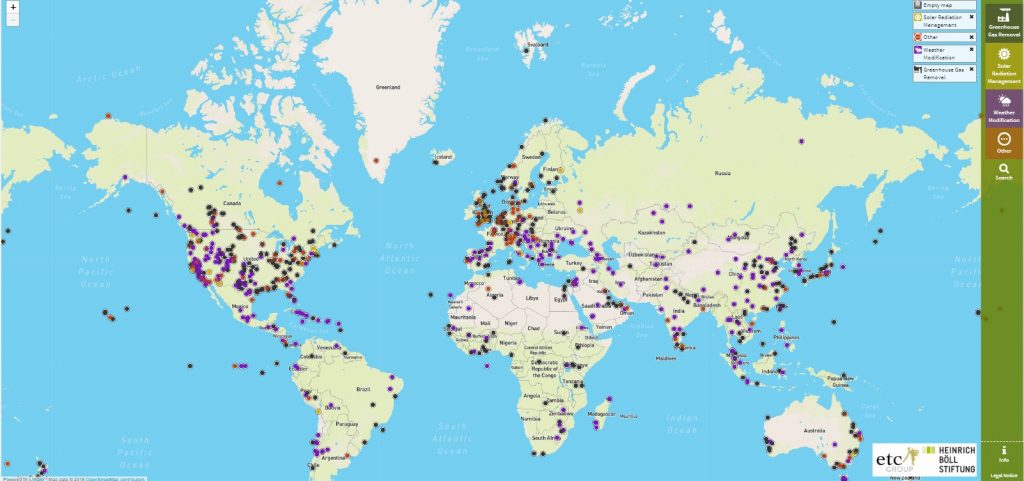September 7, 2018 – Take a look at the map below. It identifies known sites around the planet where active geoengineering projects are underway to deal with greenhouse gas emissions and climate change.

There appear to be hundreds of places where people are using technology of various sorts to address global warming, and they are doing it without any regulatory oversight. Here are some of the numbers:
Greenhouse Gas Removal Projects
- 191 carbon capture and storage (CCS)
- 80 carbon capture and use storage (CCUS)
- 35 ocean fertilization and artificial upwelling
- 20 bio-energy with carbon capture and storage (BECCS)
- 9 direct air capture (DAC)
- 8 enhanced weathering (EW)
Solar Radiation Management
- 23 stratospheric aerosol injection (SAI)
- 14 marine cloud engineering or cloud reflectivity enhancement (MCE and CRE)
- 8 microbubbles and seafoam
- 5 cirrus cloud thinning (CCT)
- 4 high albedo crops and snow forest clearance
Weather Modification
- 222 increased precipitation
- 71 reduced precipitation
- 25 combination increased and reduced precipitation
Other Projects
- 76 ongoing or completed major research
- 37 focused on algae
- 33 miscellaneous others
Sampling Some of the Projects Found on this Map
A drill down on the map referenced here (I have provided the link above) gives you an opportunity to learn more about the various geoengineering initiatives already undertaken or in planning Some projects have considerable merit. But others have been tested without consideration of unintended consequences.
Here are three that weigh on the merit side.
- Project Stormfury – is a hurricane hacking project that has involved seeding four different hurricanes to decrease the wind energy and precipitation from these powerful tropical cyclones. Not hard to argue that this type of geoengineering makes a lot of sense.
- Arcola Energy and Origen Power Greenhouse Gas Removal Prototype Plant – a 400-Kilowatt power generation facility that also removes carbon dioxide (CO2) from the atmosphere to be used by industry or sequestered permanently underground. The power generation comes from fuel cells. The world could sure use more of these types of solutions.
- Pond Technologies Carbon Abatement Algae Plant – a technology to grow algae for biofuels, fertilizers, and animal feeds by using CO2 captured from industrial sources. In this case, the plant receives its CO2 feed from an adjacent steel operation. Thousands of these types of facilities could be built globally to reduce CO2 emissions while producing valuable commercial products.
And here are two with likely unintended consequences.
- CROZEX Natural Iron Bloom and Export – a study that involved seeding an area of the ocean with natural iron to reduce ocean acidity. Studies like these have been tested over the past two decades with post-seeding algae blooms seen in the immediate vicinity of the drop.
- Moscow Institute of Global Change Aerosol Injection Experiment – a field test evaluating the injection of sulfate aerosols into the troposphere to reduce incoming solar radiation. This limited test produced incoming declines in solar radiation between 1 and 10%. The issue is we have no complete understanding of how such technology on a massive scale would impact mean global temperatures.
On the scale of these projects undertaken so far, none poses a danger to the planet. None can create a runaway natural reaction that would send our climate off in an unintended direction. But many geoengineering projects like these latter two have engineers and scientists thinking about scaling up.
In the Moscow Institute field test where sulfates were sprayed into the troposphere, many scientists express concern that on a larger scale we would see the depletion of the ozone layer to a state even worse than what occurred with hydrofluorocarbons back in the latter 20th century when holes opened over the poles.
And as for iron seeding the ocean, first done off the British Columbia coast of North America in 2012 by an American businessperson, there are consequences to encouraging large-scale algae blooms. Algae live and algae die and a sudden spike in the latter creates oxygen-robbing dead zones in the immediate post-seeding vicinity. Dead zones are aptly named, being deadly to almost all ocean life.
Enter the Climate Change Skeptics
Another interesting phenomenon coming out of the geoengineering push is how much support it gets from climate change skeptics. It’s quite funny that President Trump recently provided funding in the form of tax breaks for geoengineering schemes even though this is the man who is pulling the United States out of the Paris Climate Agreement. This is the man who claims that anthropogenic climate change is a Chinese hoax.
Add to Trump another climate skeptic who today chairs the Energy Subcommittee of the United States House Committee on Science, Space, and Technology. In a recent comment, Randy Weber described the future of geoengineering as bright. He has used his position as chair to grill scientists about a pet peeve of his, global cooling. He is also in favour of schemes like putting trillions of tiny robot reflectors into space to block the sun’s rays and, therefore, cool the atmosphere. Now, why would you want to do this if the world is going through global cooling?
Geoengineering is the equivalent to hacking the planet’s natural operating system. The biggest concern is how many patches and pieces of code we will need to test and throw away, and how many of these “experiments” will produce significant damage before we get the hack just right.
The biggest backers these days of geoengineering don’t come from the majority of scientists who study climate change and atmospheric and oceanic science. No, the biggest backers include The Heartland Institute, the Hoover Institution, and the American Enterprise Institute, all shills for the oil and gas industry, and all providing the funding for climate change skeptics who tend to become talking heads on cable and network news channels.
Hacking the planet gives those not wanting to make hard choices an easy way out. Human tinkering with the atmosphere and the ocean is seen as worth it if it means we can still drive internal combustion and diesel engines, and heat up the planet with CO2 from coal-fired power plants, and methane (CH4) from fracking operations.















